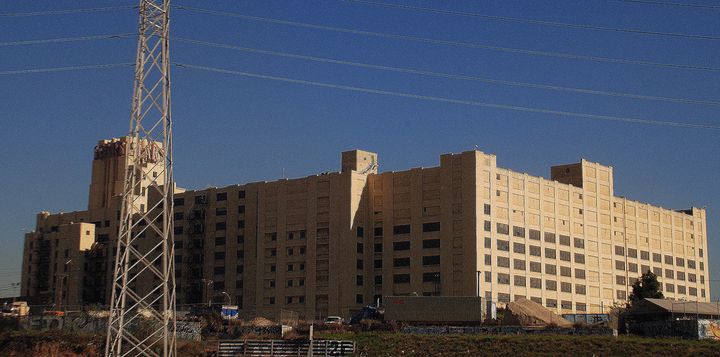
This article is part of a weekly series published in partnership with the Boyle Heights Beat. It appears every Wednesday.
By Alejandro Rojas
The most well-known landmark of the Boyle Heights neighborhood is the Sears Mail Order Building among other distinct landmarks such as Mariachi Plaza and Hollenbeck Park.
This prominent building, located at the intersection of Olympic Boulevard and Soto Street, was built in the late 1920s and served as the center of operations for the retail chain in the Southwestern region through to 1992, when Sears began scaling back operations.
An icon of Boyle Heights, the Sears Mail Order Building had been a source of community pride. During its heyday, from 1930 to 1960, this Art Deco-style building provided as many as 700 jobs, making it one of the larger employers in the area.
This once bustling edifice has now decayed into a mere shadow of its former self. Only the retail portion on the ground floor is still in use.
All the other floors stand barren. The places where accountants once balanced orders stand deserted and covered with dust. Windows are coated with a murky layer of grime, and the parking lot has no patrons.
Yolanda Hernández, 67, a former Sears employee, is one of many who mourn the building’s vanished splendor.
"This place has history," she said, as she reminisces over her 27 years with the company. "A lot of people have worked here. It was like a family."
For her and many others, this Sears site contains many memories within its walls. It is not simply the old-timers who want the site to come back to life.
"It seemed so empty," said Lisset Solis, 20, who worked at Sears as part of a Garfield High program three years ago, referring to the unused upper portions of the building, which have been sealed since 1992.
Today, though, the property faces an uncertain future. Sears, Roebuck and Co. and others have tried several times over the last decade to interest developers in acquiring the property, but have met a host of difficulties along the way.
Some people think that mixing residential and retail in the building, like the new redevelopment proposal suggests, will be key to renewing the area.
Over the course of several years, various developers have walked away from the site because they are unable to work with the conditions they face.
However local organizations, such as Unión de Vecinos and Innercity Struggle, fear redevelopment would lead to the rapid transformation of the area. Those living in the area worry that they would be crowded out as a side effect of redevelopment.
A clause in Sears' lease states that any company that redevelops the building must build Sears another store. This clause has been the main deterrent for developers. As a result, the project has been shelved indefinitely.
Mark J. Weinstein Investments, a real estate company, tried to redevelop the property after acquiring it in 2004. A new firm, Jones Lang LaSalle, recently acquired the property and has been trying to attract developers. In hopes of enticing development companies, LaSalle is promoting the location of the building and the ease of access.
Organizations such as the East Los Angeles Community Corporation (ELACC) helped organize neighbors to resist this move. Records found in the ELACC archives showed that although redevelopment continues to be proposed, nothing has come from those efforts.
Meanwhile Hernandez, among other former employess, remembers the way the store brought the community together and wishes to see vibrant life return to this place. "This Sears was like my home," she said. "They should put it to good use."
***

Alejandro Rojas is a freshman at Pasadena Community College. He graduated in June from Mendez Learning Center, where he was a member of the Decathlon Team. His favorite hobbies are reading and writing short stories and a historical novel. He dreams of collecting crystals from every continent.
This article was produced for BoyleHeightsBeat, which features the stories and blogs of community members in the Latino immigrant neighborhood of Boyle Heights, in Los Angeles, as well as the articles produced by the youth reporting staff of the Boyle Heights Beat, a bilingual quarterly newspaper and a project of the USC Annenberg School of Journalism and La Opinion.
Flickr photo by JoeInSouthernCa
WATCH RELATED: